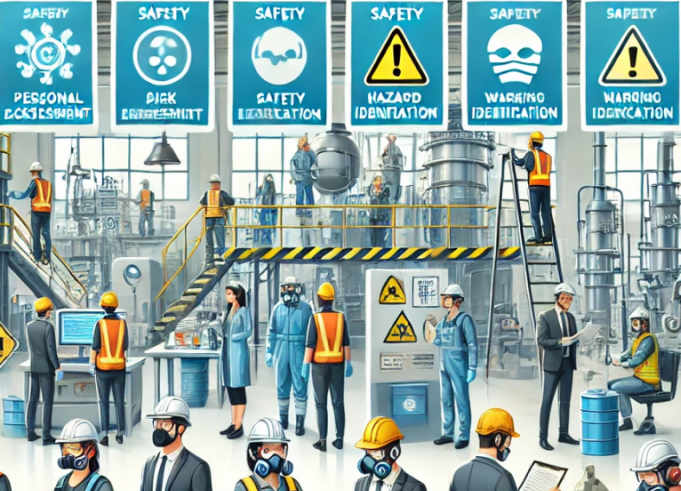In any workplace, ensuring the safety of employees is paramount. One of the most effective ways to achieve this is through a comprehensive risk assessment and hazard identification process. This crucial step not only identifies potential dangers but also helps in determining the appropriate Personal Protective Equipment (PPE) required to safeguard workers. Here’s a guide to understanding how to identify and assess workplace hazards and align them with the right PPE requirements.
1. Understanding Risk Assessment
Risk assessment is a systematic process of evaluating potential risks that may be involved in a projected activity or undertaking. It involves identifying hazards, evaluating the risk of those hazards causing harm, and deciding on measures to control the risk. The goal is to minimize the likelihood of injury or illness.
Key Steps in Risk Assessment:
- Identify the Hazards: Begin by recognizing all the possible hazards in the workplace. These can range from physical hazards like machinery, chemicals, and noise, to biological hazards like viruses and bacteria.
- Determine Who Might Be Harmed and How: Consider which employees might be exposed to the identified hazards and how they might be affected. This includes full-time employees, contractors, visitors, and even the general public.
- Evaluate the Risks and Decide on Precautions: Assess the level of risk associated with each hazard and determine the necessary precautions to mitigate these risks. This step often involves selecting the appropriate PPE.
- Record Your Findings and Implement Them: Document the hazards identified, the risks assessed, and the measures put in place. Ensure that these are communicated effectively to all employees.
- Review and Update the Assessment Regularly: Workplaces are dynamic environments, and new hazards can emerge. Regular reviews and updates to the risk assessment are necessary to maintain safety standards.
2. Hazard Identification
Hazard identification is the process of recognizing that a hazard exists and defining its characteristics. This process is crucial in the early stages of risk assessment as it lays the groundwork for determining the appropriate PPE.
Types of Workplace Hazards:
- Physical Hazards: These include machinery, electrical hazards, noise, and working from heights. PPE for these hazards may include helmets, earplugs, gloves, and harnesses.
- Chemical Hazards: Exposure to hazardous chemicals can occur through inhalation, skin contact, or ingestion. PPE such as respirators, gloves, and protective clothing can help minimize exposure.
- Biological Hazards: These involve exposure to harmful bacteria, viruses, fungi, or other biological agents. PPE may include gloves, masks, and face shields.
- Ergonomic Hazards: Poor ergonomics can lead to musculoskeletal disorders. PPE might involve supportive gloves or footwear designed to improve posture.
- Psychosocial Hazards: These relate to stress, workplace violence, and other mental health risks. While PPE is not typically used for these hazards, understanding them is crucial for a comprehensive safety approach.
3. Determining Appropriate PPE
Once hazards have been identified and risks assessed, the next step is to determine the appropriate PPE. The selection of PPE should be based on the specific risks associated with each hazard.
Steps in Selecting PPE:
- Match PPE to the Hazard: Ensure that the PPE chosen provides adequate protection against the specific hazards identified. For instance, chemical-resistant gloves should be used for handling corrosive substances.
- Consider the Fit and Comfort: PPE must fit the worker properly and be comfortable enough to wear for the duration of exposure to the hazard. Ill-fitting PPE can reduce its effectiveness and increase the risk of injury.
- Evaluate Durability and Maintenance: PPE should be durable enough to withstand the conditions of the workplace and require minimal maintenance. Regular inspections and replacements should be part of the safety protocol.
- Ensure Proper Training: Workers should be trained on how to use PPE correctly, including how to put it on, take it off, and maintain it. Proper training ensures that PPE is used effectively and reduces the risk of exposure to hazards.
4. Regular Monitoring and Review
After implementing PPE in the workplace, it’s essential to monitor its effectiveness and review the risk assessment regularly. This ensures that the PPE continues to provide adequate protection as work conditions evolve. Feedback from employees can also be valuable in identifying any issues with PPE usage or comfort.
Conclusion
Risk assessment and hazard identification are critical components of workplace safety. By systematically identifying hazards and assessing risks, employers can determine the appropriate PPE to protect their employees. Remember, the goal is not only compliance with safety regulations but also the creation of a workplace where employees feel safe and are protected from harm. Regular reviews and updates to the safety protocols ensure that the PPE remains effective, adapting to any new risks that may arise.

